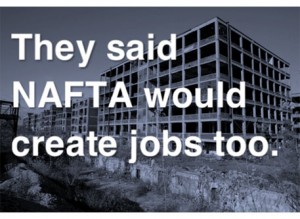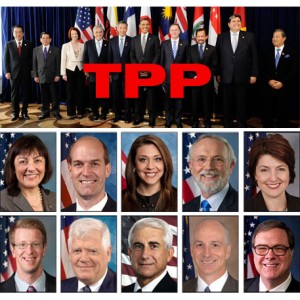OPINION
Why think tank’s rosy predictions about TPP are wrong
By CELESTE DRAKE
(Feb. 4, 2016) — One of the billionaires crusading to cut working people’s Social Security now has his sights set on making the Trans-Pacific Partnership look like a sweet deal. Hint: It’s not.
Pete Peterson’s think tank, Peterson Institute for International Economics, just released study in January 2016 predicting great economic growth from the TPP. But the PIIE methods are so detached from reality that the conclusions are wrong. Here are the reasons why.
 1) The Peterson study follows the North American Free Trade Agreement’s flawed prediction model. The computable general equilibrium model was the basis for the incorrect predictions that NAFTA and PNTR with China would help U.S. workers. The model doesn’t work well because its assumptions don’t reflect reality.
1) The Peterson study follows the North American Free Trade Agreement’s flawed prediction model. The computable general equilibrium model was the basis for the incorrect predictions that NAFTA and PNTR with China would help U.S. workers. The model doesn’t work well because its assumptions don’t reflect reality.
2) The Peterson study assumes that all economies have full employment and that trade balances won’t change. In reality, when you have a relatively weak labor market — like the United States does — it’s harder for those who lose their jobs to trade to find new jobs. And past trade agreements (like the Korea FTA) have clearly impacted the bilateral trade balance, both through changing the import-export balance directly and via new incentives to shift production. When you put false assumptions into the model, you can’t trust the results. Garbage in, garbage out.
3) The study assumes every worker who loses a job because of increased imports is automatically re-employed in a better and higher paying job. Unfortunately, this doesn’t match our experience with corporate-driven trade. And, given that Congress has been always stingy with safety net programs (like TAA) for those who lose their jobs, it is not realistic to think Congress will be more generous now.
4) The study asserts that “the higher productivity [caused by the TPP] translates into greater demand for labor and drives wages higher.” This is not a “finding” but an assumption that can easily be disproved. The link between productivity and wages broke more than 30 years ago — and not just in the United States.
 5) The study admits that the TPP will reduce the growth of manufacturing jobs, meaning 121,000 fewer manufacturing jobs than without the TPP. But it asserts that wages for skilled labor will rise because the U.S. service sector is “skilled-labor intensive.” Again, this assertion comes from wacky assumptions. U.S. workers have seen their wages stagnate as they move from manufacturing to service jobs.
5) The study admits that the TPP will reduce the growth of manufacturing jobs, meaning 121,000 fewer manufacturing jobs than without the TPP. But it asserts that wages for skilled labor will rise because the U.S. service sector is “skilled-labor intensive.” Again, this assertion comes from wacky assumptions. U.S. workers have seen their wages stagnate as they move from manufacturing to service jobs.
A new Tufts study, on the other hand, uses a different model (the United Nations Global Policy Model), which better matches reality. This means its results make more sense. As the Tufts study authors explain, the TPP will drive wages down because the 12 countries will engage in a “race to the bottom” to attract foreign investment with lower costs.
The Tufts study predicts the TPP will cost 448,000 U.S. jobs. All 12 TPP countries combined will lose 771,000 jobs. And the TPP will shrink the slice of the U.S. economic pie going to workers by 1.31%.
Fewer jobs and lower wages? The TPP is a bad deal! Make your voice heard now.
 Celeste Drake is Trade and Globalization Policy Specialist for the AFL-CIO. This column originally appeared at AFL-CIO Now.
Celeste Drake is Trade and Globalization Policy Specialist for the AFL-CIO. This column originally appeared at AFL-CIO Now.





